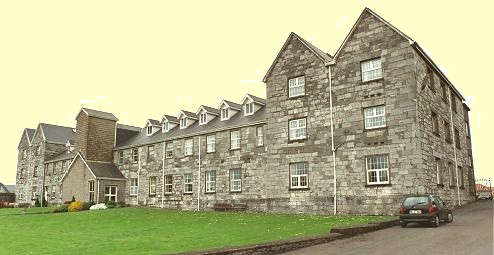
Photo: the workhouse in 2002, courtesy of Peter Higginbotham www.workhouses.org.uk
A Turkish bath was installed at Midleton Union Workhouse in 1864. Nothing is currently known about its layout or facilities, though it seems probable that it bears a family resemblance to those in nearby Lismore and Fermoy which were installed a few months earlier.
But we do know that it was well-used, and that it's existence made possible savings in a quite different area of the institution's daily work. Benjamin Johnston, Medical Officer at Midleton, gave an account of its value in his report to the Board of Guardians in April 1870.1
I beg to report that the Turkish bath of the Midleton Union Workhouse has been in active operation for the last six years, a period sufficiently long to form a somewhat correct estimate of its merits. It is in almost daily use, and is pretty generally availed of by almost all classes of the inmates, of almost all ages; and although the establishment is particularly well provided with excellent and suitable lavatories for almost all classes, still we find that the Turkish bath, although in nowise superseding them, takes its proper place as a very valuable addition, applicable in many cases in which they are not, whilst it may be stated with confidence, that by no other known mode of lavement can the same absolute cleanliness be insured, whilst its value as a means of drying the clothes (and thus affording all times an ample supply of thoroughly aired clothing at an expense not exceeding that hitherto expended on fuel for a similar purpose, which answered the purpose comparatively very inefficiently) can scarcely be over-estimated, a statement in which I am fully borne out by the master and matron, who entirely coincide in my views on this part of the subject. The schoolmaster and schoolmistress also bear their ready testimony not only to the enjoyment, but beneficial effects derived from the occasional use by the school children under their charge. In fact, both young and old seem to derive both considerable enjoyment and considerable benefit from the occasional judicious use of this invigorating luxury.
Johnston continues by indicating how the Turkish bath had helped those in the workhouse who had medical problems, and ends by summarising the value of the bath while, in effect, praising the Guardians for providing a facility which few other workhouses could equal.
In fine, as in my opinion the judicious use of the Turkish bath unquestionably tends to conduce towards and promote the general healthy tone of the establishment, I cannot refrain from expressing my opinion that neither this or any other public institution can be properly mindful of the health of its inmates, or in a word, at all complete, without being provided with this very valuable addition to its other hygienic appliances.
It is not yet known how long the bath remained in use.